2.5 Years After Demonetisation, Pune Workers’ Earnings Still Down
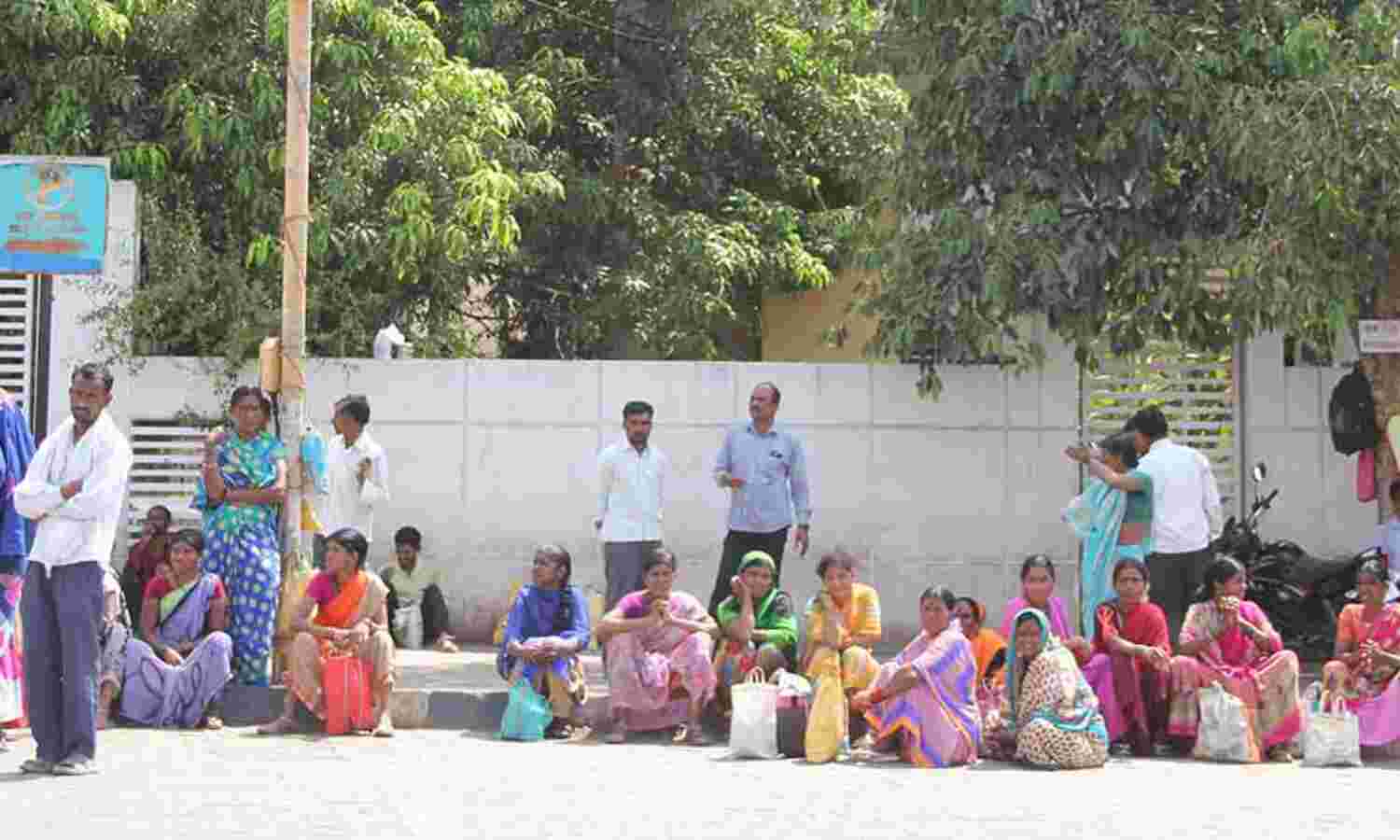
Pune: Arjun Kale, 50, a daily wage labourer in Pune, refused to vote in the 2019 Lok Sabha elections. “It makes no difference to us who is in power. All governments have ignored the needs of us labourers,” he told us on the morning of May 1 at Pune’s mazdoor adda (labour chowk).
It was 8 am and hundreds of men and women dressed in clean shirts and pants, carrying bags and digging tools, had assembled outside the Late Pruthak Barate Garden in Warje, a Pune suburb. While most organisations had the day off on account of International Labour Day, workers from the unorganised sector in the city had no option but to wait under the busy Warje flyover in hopes of finding work for the day. A few women dressed in colourful synthetic sarees could also be seen looking for employment, some carrying their children with them.
“The monsoon season is the worst for us. At times we stand under this bridge all day long, but there is hardly any work here, so we go back to our villages and work as agricultural labourers,” said Kale, an uneducated labourer from Nerle village of Karmala taluka in Solapur city, 261 km from Pune. He has been coming to the Warje mazdoor adda for the last eight years.
“Here, I earn Rs 400 a day for khodkaam (digging work) at construction sites, but in my village, agricultural labour pays only Rs 300 a day,” he said. Kale first worked as a labourer in Kankavli in Sindhudurg taluka of the Konkan region, before moving to Pune in the hope of finding more lucrative work.
His youngest son dropped out of class 12; the oldest, after completing the first year of graduation. Due to poor financial conditions, they did not pursue further education and like their father, sought out employment as daily wage labourers at the Warje labour hub. Individually, they earn around Rs 300-400 a day, a number that has not changed much since demonetisation, though the number of working days has reduced, they said.
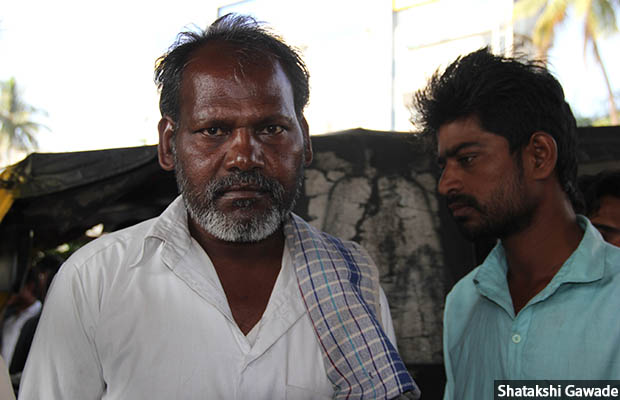
Arjun Kale, 50, refused to vote in the 2019 general election. “It makes no difference to us who is in power. All governments have ignored the needs of us labourers,” he says.
His wife and both daughters-in-law do not work. The family of six live in a slum about 2 km from the labour hub and walk to-and-fro every day. They pay Rs 3,000 for rent, and another Rs 300-400 for electricity.
Like many labourers at the adda, Kale blamed demonetisation for precipitating a fall in the demand for labourers. Earlier, he said, he would easily find a minimum of four days’ work per week, and make about Rs 2,500 a month. Now, he said, there is only two-three days’ work at best, which amounts to about Rs 1,000 in all.
This is the 10th of an 11-part series (you can read the first part here, second here, third here, fourth here, fifth here, sixth here, seventh here, eighth here and ninth here), reported from nationwide labour hubs--places where unskilled and semi-skilled workers gather to seek daily-wage or contract jobs--to track employment in India’s informal sector. This sector, which absorbs the country’s mass of illiterate, semi-educated and qualified-but-jobless people, employs 92% of India’s workforce, according to a 2016 International Labour Organization study that used government data.
By delving into the lives and hopes of informal workers, this series provides a reported perspective to ongoing national controversies over job losses after demonetisation and a transition to the Goods and Services Tax (GST) regime. The number of jobs declined by a third over four years to 2018, according to a survey by the All India Manufacturers’ Organisation, which polled 34,700 of its 300,000 member-units.
In 2018 alone, 11 million jobs were lost, mostly in the unorganised rural sector, according to data from the Centre for Monitoring Indian Economy (CMIE), a consultancy. As per the latest data released by the Periodic Labour Force Survey, under the National Sample Survey Office (NSSO), the unemployment rate as of 2017-18 stands at 6.1%, a 45-year high. The same report said that 71.1% of salaried workers in the unorganised sector--excluding the farm sector--have no official or written job contract.
Labour hubs
Pune city is host to more than 200,000 construction workers, according to Vasant Pawar, Pune secretary of the Centre of Indian Trade Unions (CITU), the labour wing of the Communist Party of India (Marxist).
Labour hubs “grow like an amoeba”, according to Satish Shirsath, a professor at the Lifelong Learning & Extension Department at Pune University, who has studied the lives of labourers at labour hubs between 2014 and 2016. In 2016, when he concluded his research, Shirsath found that Pune hosted 51 labour hubs; now, he said, this number would be higher.
“Mazoor addas (labour hubs) crop up wherever there is a need for construction labour. There is one in all the major suburbs in Pune,” said Subhash Ware, a social activist based in Pune.
Kale is one of a few hundred labourers at the Warje mazoor adda, located under a busy flyover. The workers assemble on the pavement as vehicles honk at them to pass by. There are a few small shops and eateries in the area. During the summer, an ice-cream seller cycles around, parks next to a footpath and sells a few kulfis to labourers waiting for a job. A small restaurant sells snacks like upma, poha and idli-sambar for Rs 20-50.
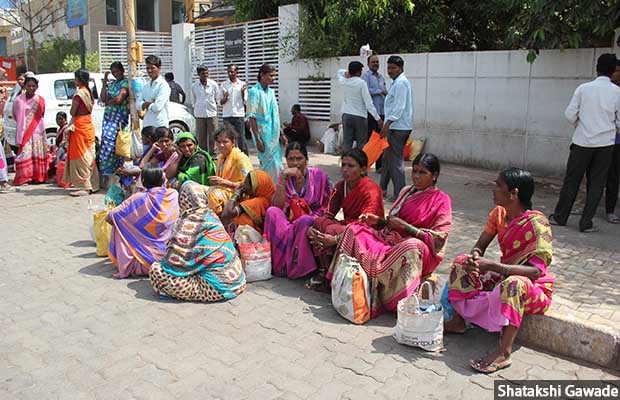
There is a labour hub in each major suburb of Pune. Here, women daily-wage labourers seek work at the Baner labour hub.
The women were all dressed in colourful synthetic sarees, adorned with earrings and necklaces, complete with silver payals (anklets). The men wore an assortment of jeans and pants with mismatched t-shirts or shirts.
With every passer-by, a glimmer of hope appeared on their faces. A few approached our team, asking “what kind of work” we would like to hire them for. On finding out that we were not labour contractors, disappointment showed on their faces and some lost interest in the conversation.
The men said they usually get hired for skilled jobs such as masonry, while the women are chosen to work as helpers, and usually paid less than the men. The skilled male labourers earn Rs 200 more than an unskilled worker for a day’s work. The consensus across the labour hub was that while there is not much of a change in the wage rates, the number of days for which work is available has reduced.
“They stand under the sun all day looking for work. There are no sanitation facilities for them, no drinking water or shade,” said Baba Adhav, a veteran trade unionist and labour rights activist based in Pune, “They build the homes we live in; the least we can do is give them a roof over their heads and one toilet so that they are comfortable when they stand at the mazoor adda.”
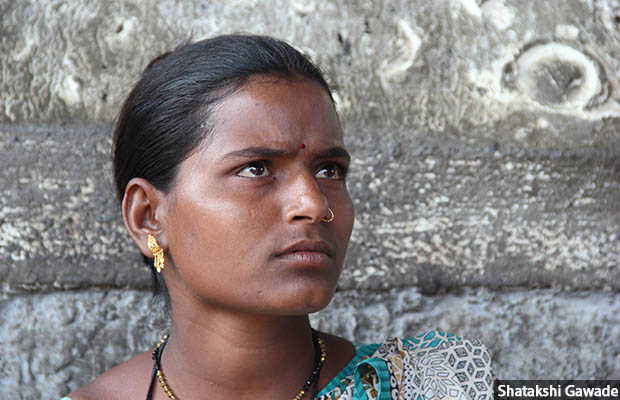
Anita Rathore, 22 and mother to a one-year-old, waiting at the Warje labour hub. She gets paid Rs 400 on a good day for carrying bricks at construction sites.
Twenty-two-year-old Anita Rathore moved from Gulbarga, Karnataka, to Pune about two months back. She was seated on a footpath at the Warje labour hub, breastfeeding her one-year-old daughter Riti, while waiting to find some construction-related work for the day. For helping out at the work site with lifting and moving bricks, she gets paid about Rs 400 on a good day. Her husband works at the labour hub along with her, and both are uneducated.
While Rathore’s three-year-old son lives with her mother back in the village, she has no option but to take Riti along to work. Her brother’s seven-year-old daughter takes care of the baby when she is working.
Rathore and her family live in a slum in Uttamnagar, Pune, about 12 km from the Warje labour hub. She and her family pay Rs 4,500 for rent, water and electricity. They take either a bus or a shared auto-rickshaw to the labour hub, spending Rs 10 per head for a one-way journey. When asked about her family’s monthly income, Rathore said it differs and that she could not put an exact figure on it.
In 2014, the Bharatiya Janata Party (BJP)-led National Democratic Alliance, their former coalition partner Shiv Sena, and the Congress party fought the state assembly (legislature) elections in Maharashtra. The BJP won 122 of the 288 seats, securing a majority, and Devendra Fadnavis became the chief minister.
The BJP had made several promises in its manifesto--regarding women’s empowerment, tribal welfare, job creation and industrial development.
For unorganised sector labourers working at sugarcane farms, in brick making or construction, the manifesto had promised healthcare, insurance cover for accidents, education for workers’ children, etc. It also spoke of issuing smart cards to labourers across the unorganised sector and establishing a “Rozgar Call Centre Yojana” to bridge the gap between labourers’ skills and employers’ needs.
However, labourers said either they were not aware of such schemes or they were not being implemented properly.
Hanumant Dubekar, 55, from Maindargi village, Akkalkot taluka of Solapur district, has worked as a construction labourer for about 15 years. He has studied up to class 2. Although he has an Aadhaar and a PAN card, Dubekar said he has never received any welfare benefits. The government has done “nothing” for labourers, he said, and complained of rising prices of petrol and other commodities. “To make things worse, this government introduced notebandi (demonetisation) and GST, which reduced our chances of getting employed even further,” he said.
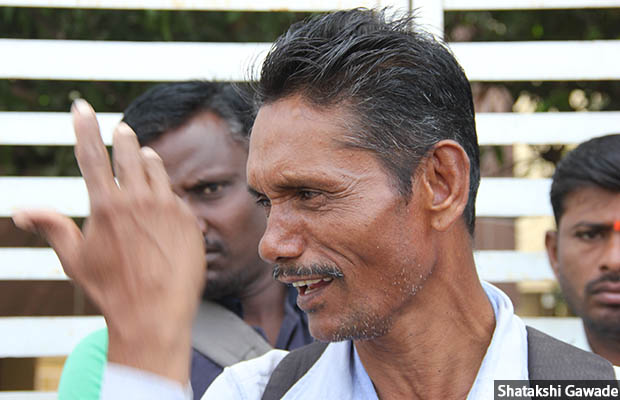
“Since the Modi government came to power, his policies have reduced our employment opportunities,” says 52-year-old Sukhdeo Jagdeo Damodar, a construction worker who says he finds hardly 10 days’ work in a month.
Construction worker Sukhdeo Jagdeo Damodar, 52, said he had even visited Mantralaya, the administrative headquarters of the government of Maharashtra, to air his grievances before the chief minister in February 2019, but his request to meet the chief minister was denied twice. “Since the Modi government came into power, his policies have reduced our employment opportunities,” he said.
Effects of demonetisation and GST
In Pune, the construction industry employs the largest number of labourers from mazoor addas, Adhav, the trade unionist, said.
Workers said they feel the lasting effects of demonetisation in the reduced number of days for which work is available.
“Money lost its sanctity'' post-demonetisation, Ravi Karandeekar, a Pune-based real estate consultant, said, “Notebandi had a psychological impact on real estate buyers. There was also an expectation that black money would be wiped out, so prospective homeowners stopped booking new property because they hoped that prices would drop. On the other hand, cash played an important role because construction workers are paid in cash, so construction slowed down.”
Since there are few jobs in villages, workers have been moving towards labour hubs in cities since demonetisation, said Dutta Chitrang, 27, a construction labourer. There is only so much work but increasing numbers of job-seekers, so that each of them finds work for fewer days.
Anuradha Kalhan, a (retired) professor of economics at Jai Hind College, Mumbai, studied the effects of demonetisation from April 2017 to May 2017 in Pune’s local markets--36.2% of the small retailers she surveyed said their sales had dropped by more than 50%. Of the 127 people surveyed across 17 wards, 12% revealed that someone in the family had lost their job, while 8% said someone in their neighbourhood was left unemployed, Kalhan’s paper, ‘Currency Shortage: Effect on Small Vendors’, said.
The effects of demonetisation were recorded across sectors. A chemist interviewed by Kalhan reported a 60% drop in sales. “The fact that demonetisation would affect the sale of medicines, an inelastic commodity, reflected the gravity of the issue. The entire informal sector was affected, where one person’s expenditure is another’s income, which is the circular flow of transactions that constitutes national income,” Kalhan told IndiaSpend. “The informal sector continues to experience the effects of this slowdown. It will only recover through external intervention, that is, job creation by the government in the unorganised sector.”
Five million men lost their jobs between 2016 and 2018, according to a study conducted by the Centre for Sustainable Employment at Azim Premji University. “The unemployment numbers are likely to be even higher among women because they are not as mobile as men. They are tied to places where their children or families live and are less likely to travel far for work,” Kalhan said.
Welfare benefits
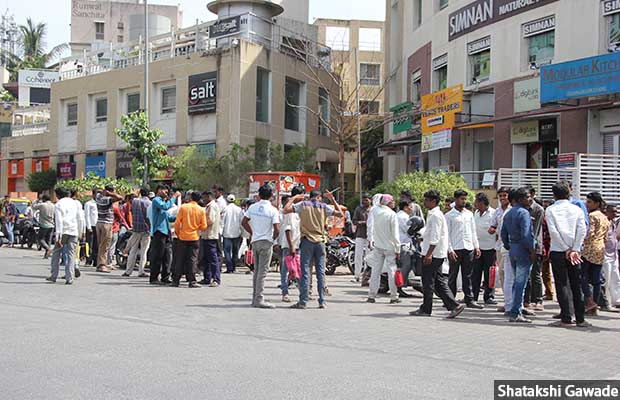
Construction workers assemble at the Baner labour hub as early as 7 am. There are 40,788 registered male construction workers in Pune.
There are 53,665 registered construction workers in Pune, of which 40,788 are male, and 12,877 female, according to the Maharashtra Building and Other Construction Workers’ Welfare Board website (BOCW).
These figures are low, particularly compared to the 200,000-or-so construction workers in Pune, as calculated by Pawar of CITU. Maharashtra was the last state to constitute a Labour Welfare Board. The state started collecting cess under the board in 2011, but only 6.8% of the cess collected so far has been spent.
Several workers we spoke to at the Baner and Warje labour hubs said they had never received any welfare benefits. None of the workers we met said they were registered as construction workers under the BOCW Act. Among the regular wage workers in the unorganised sector--excluding the agricultural sector--54.2% were not eligible for paid leave, while 49.6% were not eligible for any social security benefits, according to the 2017-18 NSSO survey.
Damodar is from Pimpalgaon Raja village in Khamgaon taluka of Buldhana district. He tried to register at the labour office as a construction worker but gave up due to the tedious process, he said: “The authorities kept asking me to come back with different documents. If I keep chasing these welfare benefits, my children will starve at home.”
Damodar has been coming to the Baner mazoor adda to find daily wage employment as a mason--a skilled profession--for the last five years. He gets paid Rs 700-800 per day now, and said before demonetisation the wages were at least Rs 1,000 per day. Before moving to Pune, Damodar worked as a mason in Mumbai. In a good month, he said, he finds about 10 days of work. Having never received a formal education, he said he hoped his daughter and two sons would complete their education, but it is a struggle.
The family live about 2 km from the labour hub, in a slum on Aundh DP Road. Damodar pays Rs 5,000 as rent and Rs 1,000 for electricity every month. His wife is not educated and does not work. His monthly income before demonetisation was about Rs 15,000, which has now dropped to less than Rs 10,000.
“Construction labourers have to forfeit a day’s wages every time they need to go to the labour office and they must go multiple times to get themselves registered,” said Pawar of the CITU. The process to complete this registration is dreary: to be considered eligible, a labourer would have to secure a ‘pramaan patra’ (a certificate from the employer) to prove they have worked for 90 days in the previous year.
There are several loopholes with this process, said Nitin Pawar, a Pune-based social activist who works for the rights of workers in the unorganised sector. Providing a contractor’s acknowledgement of 90 working days “is extremely difficult” since employers hire labourers “casually”--for shorter durations, with no contract. Moreover, it is not compulsory for an employer to hire workers registered under the Act.
A few workers we spoke to said they did not know their employers’ names. Acquiring written proof of their work for 90 days seems unrealistic when most construction workers are uneducated. “The levels of education and awareness are low among the mazoor adda workers,” said Shirsath.
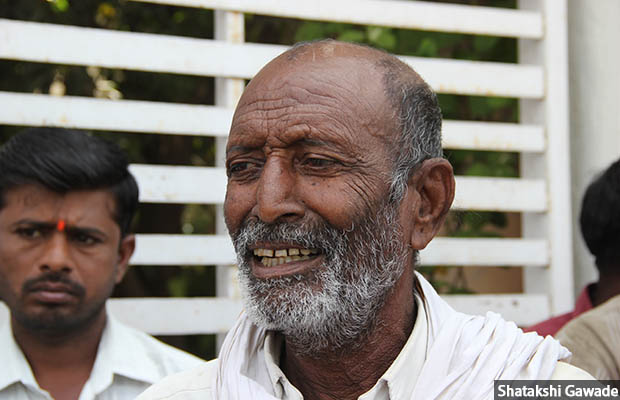
Ganpath Mundkar, 77, at the Baner labour hub, has been working as a construction labourer for 40 years. Unaware of benefits earmarked for unorganised sector workers, he has never received any.
Seventy-seven-year-old Ganpath Mundkar is from Bawalgaon village in Bidar district of Karnataka; he moved to Pune about 40 years back and has been working as a construction labourer since then. Of his two sons, one has completed a diploma in education, and the other has completed higher secondary education. Both are unable to find jobs commensurate with their education, and work as construction workers at the same labour hub as their father.
Only those between the ages of 18 and 60 are eligible to register themselves as beneficiaries of the welfare schemes; this registration must also be renewed every year, according to Section 12 of the BOCW Act, 1996. However, having never been registered under the BOCW Act because he is not aware of the benefits, Mundkar has missed the opportunity of receiving any.
As has Babanrao Haribhau More, 52, who worked for the same construction company for 10 years, and was laid off recently because he started losing his hearing--an occupational hazard of working in construction. Schedule II and Section 31 of the BOCW Act prohibit employers from hiring persons who are hearing- or vision-impaired. He has not been registered under the BOCW Act; in fact, he has not even heard of it.
“We insist that registration of workers be made compulsory and that the workers’ self-declaration be considered valid for registration,” said Pawar of CITU. The legal mechanism for implementing the Act needs to be improved, and the “inefficient and time-consuming” registration process beefed up, he said.
This is the tenth of 11 reports. Read the previous stories from Indore, Jaipur, Perumbavoor, Ahmedabad, Kolkata, Lucknow, Bengaluru, Bathinda and Haryana.
Correction: An earlier version of the story erroneously said 3.5 years since demonetisation. The correct datum is 2.5 years since demonetisation. We regret the error.
(Kurtkoti is a Pune-based freelance writer and a member of 101Reporters.com, a pan-India network of grassroots reporters.)
We welcome feedback. Please write to respond@indiaspend.org. We reserve the right to edit responses for language and grammar.


